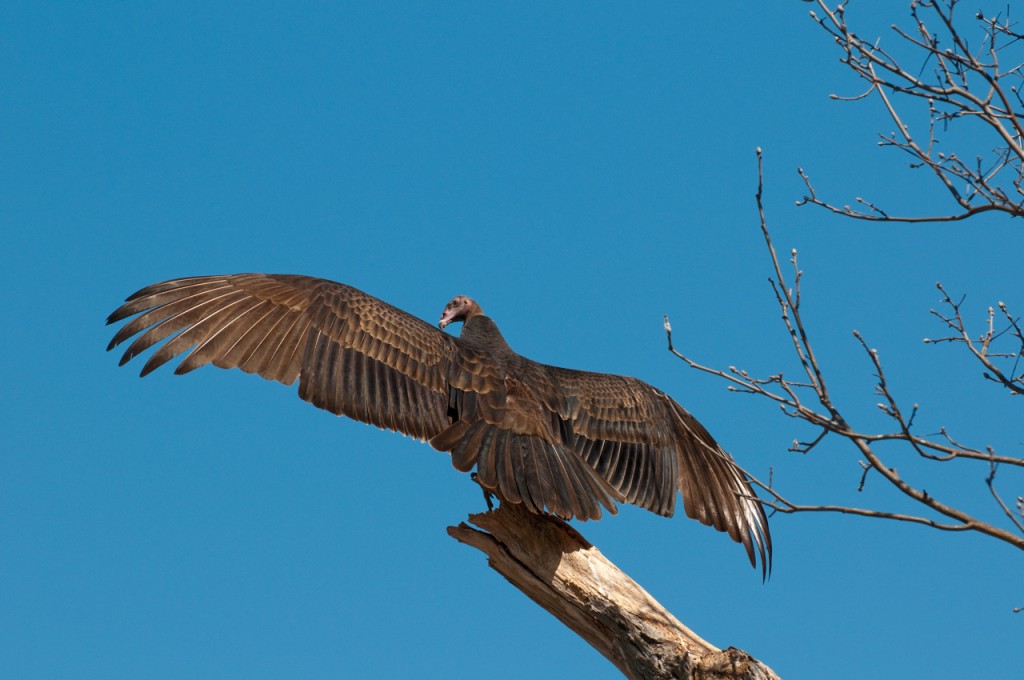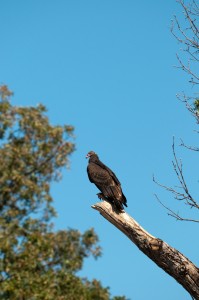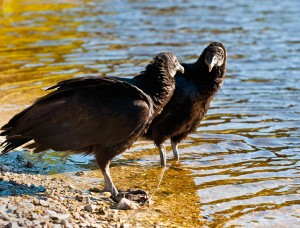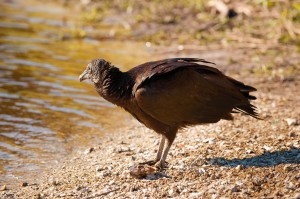Nature’s Cleanup Crew: Vultures
Although members of The Turkey Vulture Society proudly display their unofficial slogan – ‘I brake for carrion’ – on bumper stickers, for most people, the thought of vultures most often calls forth memories of Western movies in which the hero’s fate was left to dark birds circling ever nearer. This idea of vultures’ waiting to delight in weakness and death received recent recapitulation in financial news, such as a New York Times headline ‘Vulture Investors to the Rescue.’
In cultural traditions, “buzzards,” as vultures are commonly called, have been honored far less often than feared and detested.
In the New World, in pre-modern times, Native Americans of our eastern woodlands revered the vulture. A legend had it that at the beginning of the world, no birds on earth had any feathers, a distressful situation in need of remedy. Told
that soft feather coverings could be obtained at a very distant place, the large, strong vulture was selected to journey in search of feathers. During the long trip, the vulture could not find his usual diet of seeds and fruit and was forced to eat carrion for the first time. As the vulture collected feathers, he saved the most beautiful for his own head. But, in flight, the feathers would not stay on his head and he had no choice but to remain bald. When he returned, he gave all of the feathers, except his black body feathers, to all of the other birds. As a reward for his selflessness, the vulture was assigned the honored role of carrying the souls of the dead into the next world.
In the Old World, the ancient Egyptians also revered vultures. A vulture goddess, Nekhebet, was the protector of the pharaohs of Egypt. She was considered a mother goddess, and her vulture image was incorporated into crowns and headdresses of Egyptian queens. The ancient Greeks, however, saw vultures as harbingers of ruin and death, and assigned this symbol of disaster to their god of war, Ares. This tradition of viewing vultures as evil carried over to Europeans, and to some of their immigrant descendents to America, who viewed the vulture as a symbol of death.
The association of vultures with death was a logical mindset since vultures primarily eat carrion and carcasses. But the scavenging of carrion provides two vital and valuable environmental services. First, the carcasses are eliminated. And, second, the corrosive acid in the digestive system of vultures kills the bacteria of potentially dangerous pathogens, such as salmonella, cholera, anthrax, and botulism. The clean up work vultures do is recognized in the scientific family name – Cathartidae – derived from a Greek word meaning “to purify.”
The sanitation services provided by vultures were readily recognized by earlier generations of Americans. During of the eighteenth and nineteenth centuries – a time of draft animal labor and the necessity of local and constantly operating butchering facilities — throughout most of the United States, vultures were viewed as essential to public health. Villages, farmsteads, and especially municipalities, had dumping grounds for animal carcasses, and cleanup was left to the vultures.
There are three species of vultures in North America. While their appearance and carnivorous diet makes them seem close kin to birds of prey, New World vultures are not closely related to the raptors. DNA analysis has shown that vultures are not true raptors; anatomical and behavioral studies indicate they may be more closely related to New World storks.
The California Condor, made famous by its near-extinction is the largest vulture in North America, has a 47-inch length and a nine-foot wingspan. About 100 birds have been released from the successful captive breeding program, and condors again soar the skies in California, Utah, and Arizona.
Two species of vultures are common in our bluff lands. Turkey Vultures are the
most often sighted. With a featherless red head, white bill, and brown legs, the 27-inch long vulture has a six-foot wingspan. Underside wings are two-toned silver and gray and topside feathers are black.
Black Vultures are slightly smaller, at 25-inches long with a five-foot wingspan. Black Vultures have black heads, white feet, and a less silvery underside wing condition.
Both Turkey and Black Vultures are masters at soaring on warm thermal updrafts of air, gliding effortlessly. Turkey Vultures, in fact, seldom flap their wings while soaring, and exhibit a telltale tippy-wobbly glide pattern. Their wings are held at a high angle up from their body, a ‘V” formation known as a “dihedral,” which distinguishes their flight. Black Vultures also glide with little effort but hold their wings in a much flatter flight position. Both species will often soar together, in spiraling, social formations, called kettles. Turkey and Black Vultures also will roost communally together in trees or on bluff top crags at night. At dawn, they unfold their wings to warm in the sun before setting off scavenging for food.
Exactly how vultures find their food has long been controversial. John James Audubon disbelieved the conventional wisdom of the early nineteenth century and scoffed at the notion of vultures locating food by scent alone. He conducted a series of experiments that showed sight, not smell, led vultures to food and presented this evidence in his first publicly read scientific paper in 1826 in Edinburgh, Scotland. But
Audubon was only partially correct: Black Vultures indeed do not have a highly developed sense of smell but Turkey Vultures have an acutely accurate olfactory sense.
A Turkey Vulture can smell and locate a dead mouse – even one covered by leaves — from a 200-foot distance. Both Black and Turkey vultures have well-developed visual systems – experiments show them able to spot a road-killed snake while flying from one-half mile away. Turkey Vultures also are attracted to and investigate mushrooms and flowers that emit a carrion-like scent.
Lack of head feathers probably is an adaptive result and may aid in cleanliness
while feeding. Both species are able to draw up the feathered area on the lower neck to cover the bare skin of the upper neck during cold weather. Another unique behavior is “urohydrosis,” urinating on their own legs, apparently to cool and help regulate body temperature. This particular behavior, a keen observer recently noted in Birding magazine, may provide other functions – perhaps a form of cleansing — since vultures urinate on their legs even in cold weather.
Turkey and Black Vultures regurgitate indigestible foodstuffs, in a smelly concentration called pellets. Analysis of pellets has shown that a significant portion of a Turkey Vulture’s diet is vegetable material, including grass; Black Vultures also are known to eat vegetable matter, particularly pumpkins
Neither Turkey nor Black Vultures build nests. They lay normally two eggs in a single clutch on the ground or in a log or low tree cavity, in late April. Both parents, which mate for life, tend to the hatchlings, feeding them regurgitated carrion. On nesting sites, pellet accumulation creates a putrefying odor. And, would-be predators should be wary, because a vulture – even a juvenile — can accurately aim and fire pellet discouragement for a six-foot distance. Parental care continues for about 10 to 11 weeks until the youngsters gain their feathers and can fly.
Turkey and Black Vultures have expanded their geographic ranges over the last 100 years. Once only present this far north during the breeding season, Turkey Vultures, particularly first year birds, increasingly spend all year in our area. And, in the last 30 years, Turkey Vultures have extended their breeding range into Canada. Black Vultures, which just a few years ago could only be spotted in summer in the Illinois counties along the Ohio River, have now established breeding sites northward to just about Monroe County, and are regularly seen here in mid-summer. Their range expansion may be due to the exponentially increased availability of road-killed carrion made possible by increases in roadways, vehicles, and collisions with the ever-growing whitetail deer populations.
Our lands offer unique vulture watching vantage points, as an observer at the top of the bluffs can easily peer out and look down on the impressive site of a kettle of vultures circling and rising on thermal heat columns forming over the rich river bottom lands. While we do not see them either as protectors of pharaohs or as ferrymen of dead souls, we may admire the effortless grace and form, and, perhaps, remember a thanks for sanitation services.
Clifftop, a local nonprofit organization, is focused on preserving and protecting area bluff lands.
Versions of this article appeared in the March 4 2009 edition of the Suburban Journals Clarion Enterprise, and in the March 6, 2009 edition of the Monroe County Independent.
© 2009 all content rights reserved, Clifftop NFP.
Comments are currently closed.




